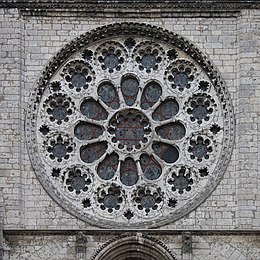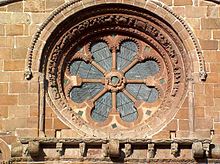Wheel window

A wheel window is a round window in which the window opening is divided by "spokes" made of wood or stone. Wheel windows are preliminary stages of the Gothic rose windows , but they often take on and vary the shape of a wheel window.
history
Wheel windows are typical window shapes in high and late Romanesque architecture . Their origins - and thus their first appearance - have not been explored. According to the current state of knowledge, it can be assumed that the earliest wheel windows were made in Italy in the 11th century. Memories of the Christ monogram may also have played a role in the creation of six-spoke wheels . Some of the considerations of architectural historians are that the increasingly larger round windows ( oculi ) on the west or transept facades of many churches were initially closed by wooden wheels in order to achieve a decorative effect. These wheels were later glazed to keep rainwater, birds and other animals away. Very soon - but long before the appearance of the Gothic tracery (around 1215) - these wooden constructions, of which nothing has survived, were imitated in stone, with the spokes regularly designed as small columns; however, the middle wheel axle was retained.
construction
Regular cases

Depending on the size of the window, the number of fields of the same size also changes: Originally there were mostly eight, but the symbolic number of twelve quickly became very popular; However, there are also later wheel windows with 24 spokes or fields ( Modena Cathedral ) and more. In Central Europe, the wheel windows are being replaced by the Gothic rose windows , which, however, still adhere to the construction principles of the wheel windows for a long time ( Strasbourg Cathedral ), but usually no longer have spokes in columnar form.
Special case
In the north transept of the abbey church of Saint-Remi in Reims there is a Gothic wheel window, which - due to the alternating smaller and larger fields or the shorter and longer spokes - seems to turn optically.
distribution
Wheel windows are found in sacred architecture in large parts of southern and central Europe, but predominantly in Italy - and more rarely in Spain, France, England and Germany. They can be found almost without exception in the upper part of the west and / or transept facades, where they can sometimes protrude into the gable field .
symbolism
Wheel windows are sometimes referred to as "Katharinenfenster", based on the torture tool of St. Catherine . In a few cases ( Basel Cathedral , Saint-Etienne in Beauvais ) they are clearly also as a warning wheel of fortune or Fortunarad to understand, as the figures in the windowsill rise times or times down fall. In general, like the rose windows, they can be seen as 'donors of heavenly light' - this is probably one of the reasons why the number of twelve spokes that often appear plays such a dominant role.
ornament
In contrast to the rich and extremely experimental tracery , wheels as an ornamental shape on wall supports or on choir stalls, etc., hardly appear.
photos
Verona , San Zeno Maggiore - west facade
Tuscania , San Pietro - west facade
Beauvais , St-Étienne - Wheel window with wheel of fortune
literature
- Wiltrud Mersmann : The importance of the round window in the Middle Ages. Unprinted dissertation Vienna 1944.
- Wiltrud Mersmann: Rose window and heavenly circles. Mäander, Mittenwald 1982, ISBN 3-88219-195-3 .
- Painton Cowen: The Rose Windows of the Gothic Cathedrals. Herder, Freiburg 1984, ISBN 3-451-18629-2 .




